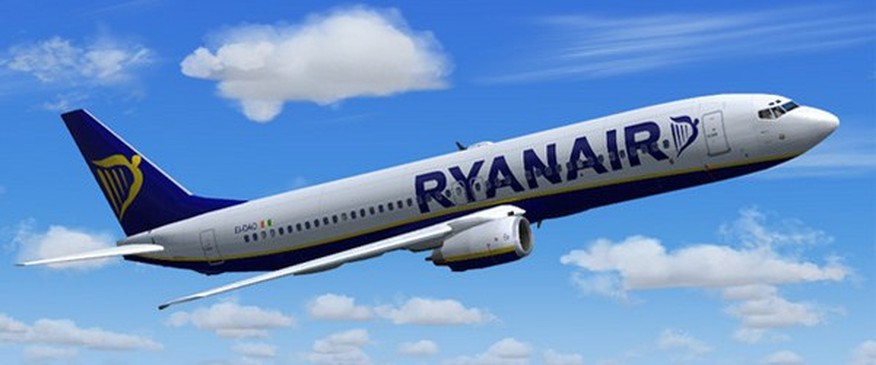Every year thousands of Americans experience wanderlust, an overwhelming desire to travel, and take a journey “across the pond” to experience all that Europe has to offer. A transatlantic expedition, however, often comes with a hefty price tag. Last month RyanAir made dreams come true for American travelers when it announced it would be offering $15 one-way flights from Europe to America in the future. While it sounded too good to be true, the airline explained how charging for add-ons and premium seating would subsidize the low base fair, thus making the plan plausible. However, dreams were crushed when Forbes gave us all a reality check on Friday morning: $15 flights from America to Europe are not going to happen. At least, not any time soon.
RyanAir is an airline based out of Ireland that offers low-cost travel between European countries. Founded in 1985 by the Ryan family for whom the airline is named, Ryanair describes itself as “Europe’s only ultra low cost carrier.” It promises “no-frills, low-cost, get-you-from-A-to-B” travel and currently flies to over 30 countries daily. On Monday, March 16, Ryanair released a statement announcing that the airline “would like to offer low cost flights between 12-14 European cities and 12-14 US cities.” The statement confirmed plans announced in 2013 for transatlantic expansion of the company.
The good news was short lived; on March 20, 2015, Ryanair’s board of trustees released a statement denying having approved CEO Michael O’Leary’s plans for expansion: “In the light of recent press coverage, the Board of Ryanair Holdings Plc wishes to clarify that it has not considered or approved any transatlantic project and does not intend to do so.” While O’Leary sits on the board, he claims that the announcement was a miscommunication. He told the New York Times on Friday, March 20, “we screwed up.”
O’Leary has a history of making “outrageous” statements to the press, which often describes him as a “colorful” character in the business world. In 2010 O’Leary announced his plan to remove 10 rows of seats from select planes and to offer 15 rows of “vertical seating,” a standing-room-only option that would reduce flight cost to approximately $6 per vertical seating passenger. In 2011 O’Leary announced his plan to charge one euro for using the bathroom in flight, which caused a frenzy.

Thankfully, neither of these ideas came to fruition.
O’Leary has been criticized for making claims in order to draw attention to his airline rather than to deliver on the proposed plan. It may be that his promises of $15 transatlantic flights are a similar publicity stunt.
Fact or fiction, travelers and critics alike took to the Internet to discuss what the expansion would mean for the United States. While $15 transatlantic travel seems like a budget traveler’s dream, critics have posed the question: would the price be worth the experience? Ryanair is famous for bare-fare pricing, but when considering the amenities offered by standard airlines on transatlantic flights, Ryanair is at a disadvantage. Their proposed too-cheap-to-be-real transatlantic package includes:
- For $15: a seat on the plane, one carry-on bag, and one personal item
- $65 for a 45 lbs. bag
- $4 for water
- $4 for hot beverages
- $9 for alcoholic beverages
- $9 for an in-flight meal
- Limited entertainment available for purchase, including in-flight movies, television, and Wi-Fi
As part of their business model Ryanair plans to subsidize the low-cost bare fair by offering an increased number of premium and business options, as well as charging additional fees. While it is technically possible to pay just the $15 base fee, the lack of transparency used when charging additional fees makes it a challenging endeavor. On a flight from London to New York, which averages eight hours, it is realistic to assume that passengers will opt to partake in one or more of the optional amenities.
Additionally, RyanAir utilizes smaller, cheaper airports to cut costs. Instead of flying into major airports like Philadelphia International or Boston’s Logan International Airport, travelers would arrive in smaller nearby destinations such as Trenton-Mercer Airport in Trenton, NJ or T.F Green Airport in Providence, RI. Flying to “remote” destinations compromises the convenience of the cheap fare, and it would require passengers to pay for alternate travel accommodations to reach larger destinations.
If O’Leary’s grandiose plans to expand Ryanair “across the pond” materialize, experts say it could take years. A Ryanair spokesperson told the Huffington Post that “the business plan is there but it’s dependent on attaining viable long haul aircraft and we estimate that’s four to five years away.” Both Boeing and Airbus have developed fuel-efficient long-haul passenger jets that have become popular for long distance air travel. Due to the high volume of orders for the Boeing Dreamliner and Airbus A350 Jet by higher priority airlines Ryanair could wait even longer for expansion.
Should travelers look forward to cheap transatlantic airfare? In short, not any time soon. But talk of lowering prices could spark legacy airlines, such as US Air and Delta, to do the same. Ryanair, and its American counterpoint, Spirit Airlines, are making travel more inexpensive than ever imagined, and are pushing airlines to continually lower costs. Finding a cheaper way to fly, whether with the use of fuel-efficient vehicles or pay-as-you-go extras has forged the way for an era of cheaper, more accessible airfare.
– By Laura Pontari/Photo Credit: agafe.es
